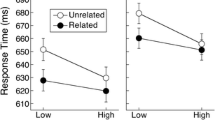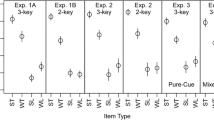Abstract
In a recent experimental paper Lee et al. (Neuron 51:639–650, 2006) showed that the firing patterns of CA1 complex-spike neurons gradually shifted forward across trials toward prospective goal locations within a recording session over multiple trials. Here we propose a simple model of this result based on the phenomenon of awake sequence reverse replay (Foster and Wilson, Nature 440(7084):615–617, 2006) which occurs when the animal pauses at the reward location. The model is based on the CA3-CA1 anatomy with modulation of CA3-CA1 synaptic plasticity by feedback from CA3 projecting CA1 interneurons. Sequence replays, which are generated in CA3 by removal of subcortical inhibition on CA1 interneurons, are recoded into the synaptic weights of individual CA1 cells. This produces spatially extended CA1 firing fields, whose response provides a value function on experienced paths toward goal locations. Simulations show that the CA1 firing fields show positive movement in center of mass toward reward locations over many trials with negative shift in first few trials, and development of positive skew.





Similar content being viewed by others
References
Anderson MI, Jeffery KJ (2003) Heterogeneous modulation of place cell firing by changes in context. J Neurosci 23:8827–8835
Baker JL, Olds JL (2007) Theta phase precession emerges from a hybrid computational model of a CA3 place cell. Cogn Neurodyn 1:237–248
Behrens CJ, van den Boom LP, de Hoz L, Friedman A, Heinemann U (2005) Induction of sharp wave ripple complexes in vitro and reorganization of hippocampal networks. Nat Neurosci 8:1560
Bikbaev A, Manahan-Vaughan D (2008) Relationship of hippocampal theta and gamma oscillations to potentiation of synaptic transmission. Frontiers in neuroscience 2: 57
Bower MR, Euston DR, and McNaughton BL (2005) Sequential- context-dependent hippocampal activity is not necessary to learn sequences with repeated elements. J Neurosci 25:1313–1323
Breese CR, Hampson RE, Deadwyler SA (1989) Hippocampal place cells: stereotypy and plasticity. J Neurosci 9:1097–1111
Buzsaki G (1989) Two-stage model of memory trace formation: a role for “noisy" brain states. Neuroscience 31:551–570
Buzsaki G, Chrobak JJ (2005) Synaptic plasticity and self-organization in the hippocampus. Nat Neurosci 8:1418
Dunwiddie T, Lynch G (1978) Long-term potentiation and depression of synaptic responses in the rat hippocampus: localization and frequency dependency. J Physiol 276:353–367
Eichenbaum H (2000) A cortical-hippocampal system for declarative memory. Nat Rev Neurosci 1:41–50
Ferbinteanu J, Shapiro ML (2003) Prospective and retrospective memory coding in the hippocampus. Neuron 40:1227–1239
Foster DJ, Wilson MA (2006) Reverse replay of behavioural sequences in hippocampal place cells during the awake state. Nature 440(7084):615–617
Foster DJ, Wilson MA (2007) Hippocampal theta sequences. Hippocampus 17(11):1093–1099
Freund T, Antal M (1998) GABA-containing neurons in the septum control inhibitory interneurons in the hippocampus. Nature 336:170–173
Freund T, Buzsaki G (1996) Interneurons of the hippocampus. Hippocampus 6:347–470
Fyhn M, Molden S, Hollup S, Moser MB, Moser E (2002) Hippocampal neurons responding to first-time dislocation of a target object. Neuron 35:555–566
Gothard KM, Skaggs WE, Moore KM, McNaughton BL (1996) Binding of hippocampal CA1 neural activity to multiple reference frames in a landmark-based navigation task. J Neurosci 16:823–835
Hafting T, Fyhn M, Molden S, Moser MB, Moser EI (2005) Microstructure of a spatial map in the entorhinal cortex. Nature 436:801
Jensen O, Lisman JE (1996) Hippocampal CA3 region predicts memory sequences: accounting for the phase precession of place cells. Learning & Memory 3:279–287
Johnston D, Amaral DG (1998) Hippocampus. In: Shepard GM (ed) The synaptic organization of the brain. Oxford University Press, New York, pp 417–458
Kamondi A, Acsady L, Wang X-J, Buzsaki G (1998) Theta oscillations in somata and dendrites of hippocampal pyramidal cells in vivo: activity-dependent phase-precession of action potentials. Hippocampus 8:244–261
Kobayashi T, Nishijo H, Fukuda M, Bures J, Ono T (1997) Task dependent representations in rat hippocampal place neurons. J Neurophysiol 78:597–613
Lee I, Yoganarasimha D, Rao G, Knierim JJ (2004) Comparison of population coherence of place cells in hippocampal subfields CA1 and CA3. Nature 430:456–459
Lee I, Griffin AL, Zilli EA, Eichenbaum H, Hasselmo ME (2006) Gradual translocation of spatial correlates of neuronal firing in the hippocampus toward prospective reward locations. Neuron 51:639–650
Leutgeb S, Leutgeb JK, Treves A, Moser MB, Moser EI (2004) Distinct ensemble codes in hippocampal areas CA3 and CA1. Science 305:1295–1298
Lisman JE (1999) Relating hippocampal circuitry to function: recall of memory sequences by reciprocal dentate-CA3 interactions. Neuron 22:233–242
Lisman JE, Otmakhova NA (2001) Storage, recall, and novelty detection of sequences by the hippocampus: elaborating on the SOCRATIC model to account for normal and aberrant effects of dopamine. Hippocampus 11:551–568
Markus EJ, Qin YL, Leonard B, Skaggs WE, McNaughton BL, Barnes CA (1995) Interactions between location and task affect the spatial and directional firing of hippocampal neurons. J Neurosci 15:7079–7094
McClelland JL (1998) Complementary learning systems in the brain. A connectionist approach to explicit and implicit cognition and memory. Ann N Y Acad Sci 843:153–169
Oliveira LA, Gentil CG, Covian MR (1990) Role of the septal area in feeding behavior elicited by electrical stimulation of the lateral hypothalamus of the rat. Braz J Med Biol Res 23:49–58
O’Keefe J, Nadel L (1978) The hippocampus as a cognitive map. Oxford University Press, Oxford
Ponzi A (2006a) Dynamical system model of spatial reward learning. IEICE Tech Rep 103(163):19–24
Ponzi A (2006b) Simple model of hippocampal splitter cells, Japan neural network society (JNNS 2006) abstract.
Ponzi A (2007) Model of balance of excitation and inhibition in hippocampal sharp wave replays and application to spatial remapping. IJCNN 2007, IEEE press, pp 2373–2378.
Schroeder BE, Binzak JM, Kelley AE (2001) A common profile of prefrontal cortical activation following exposure to nicotine or chocolate. Neuroscience 105:535–545
Sik A, Minen A, Penttonen M, Buzsaki G (1994) Inhibitory CA1-CA3-hilar region feedback in the hippocampus. Science 265:1722–1724
Skaggs WE, McNaughton BL, Wilson MA, Barnes CA (1996) Theta phase precession in hippocampal neuronal populations and the compression of temporal sequences. Hippocampus 6:149–172
Somoyogi P, Klausberger T (2005) Defined types of cortical interneurone structure space and time in the hippocampus. J Physiol 562(1):9–26
Stanley BG, Lanthier D, Leibowitz SF (1988) Multiple brain sites sensitive to feeding stimulation by opioid agonists: a cannula-mapping study. Pharmacol Biochem Behav 31:825–832
Wallenstein GV, Hasselmo ME (1997) GABAergic modulation of hippocampal population activity: sequence learning, place field development, and the phase precession effect. J Neurophysiol 78:393–408
Wood ER, Dudchenko PA, Robitsek RJ, Eichenbaum H (2000) Hippocampal neurons encode information about different types of memory episodes occurring in the same location. Neuron 27:623–633
Author information
Authors and Affiliations
Corresponding author
Rights and permissions
About this article
Cite this article
Ponzi, A. Forward shift from reverse replay. Cogn Neurodyn 3, 39–46 (2009). https://doi.org/10.1007/s11571-008-9068-7
Received:
Revised:
Accepted:
Published:
Issue Date:
DOI: https://doi.org/10.1007/s11571-008-9068-7




